お問い合わせ先
Research Cooperation Division I,
International Program Department,
Japan Society for the Promotion of Science (JSPS)
5-3-1 Kojimachi, Chiyoda-ku, Tokyo 102-0083, JAPAN
TEL
+81-3-3263-1944
TEL
fos*jsps.go.jp
Note: Please replace*with @.

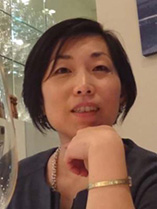 |
Yuriko Yamanaka Past FoS participation |
|---|
I have participated three times in Japanese-German Frontiers of Science (JGFoS) symposiums co-organized by the Alexander von Humboldt Foundation (AvH) in Germany and the Japan Society for the Promotion of Science (JSPS) during the period from 2011 to 2013. I was a general participant in the 8th JGFoS symposium held in Tokyo in 2011 and was then appointed twice to serve as a planning group member (PGM) of the Social Sciences session at the 9th and the 10th JGFoS symposiums held in Potsdam and Kyoto. That said, I had no idea what these symposiums would be like before I actually participating in them.
The first year: Out of my league?
My research is in comparative literature and culture, and I work at the National Museum of Ethnology which is a research center and museum of anthropology. When I was first invited to attend a Frontiers of Science symposium, I had very little contact with natural science researchers. I was uncertain as to whether I could make any contribution to the discussions, and more fearful that I might not be able to follow it at all. Besides, I would participate as a member of the symposium’s Social Sciences session even though I am not a social scientist. Pessimistically, I thought I would be ill-received by “real” scientists who would say, “What have you got to do here? Humanities is not a science!” Full of skepticism, I made my way through the halls of the Hotel New Otani to the symposium’s venue.
The first session was on ‘Earth Science’ and its topic addressed oceans and the atmosphere. One of the speakers on the German side spoke about “eddy,” showing pictures of ships and the sea. Though the presentation title contained the term and I had read the abstract and glossary, I still couldn’t figure out what the word “eddy” meant. I had never heard it used except as a male name. I grumbled to myself, “So who is this Eddy? Is he your uncle, or what?” But, I patiently kept quiet, having no courage to raise my hand and say, “May I ask you a very basic question...” Undoubtedly, I was intimidated by the thought that I was the only person in the room who did not know the meaning of “eddy.” After the session had finished, (my curiosity having gotten the best of me) I turned to another participant and asked, “Do you know who/what “eddy” is?” In reply, he said, “Well, I’m not sure because it’s not a term in my field. But, from the context of the presentation, I imagine it means something spinning round and round...” As his degree of educated guessing roughly corresponded to my level of understanding, I felt a little relieved.
After I went back to my room in the hotel, I searched the Internet for the origin of the word, and found that it came from Old Norse ‘iða,’ which means to swirl. The word later morphed into ‘ydy’ in Scottish and then ‘eddy’ in English. Ah, so it’s a word from the tongue of the seafaring Vikings! Being an inlander myself, I have never heard the word in daily use, but it seems to have become a scientific term used in environmental studies. I was glad to discover this point of interface between history and culture and modern science. (Speaking of “eddy,” I recently found on the Internet that there was a local hero in Japan’s Tokushima Prefecture called Uzu-senshi --swirl warrior-- Eddy.)
From then on, I did not hesitate to ask questions whenever something was unclear to me, being curious and inquisitive by nature. Hence I started to enjoy the symposium. I must of have stuck out because soon I was asked to serve as a PGM for the next JGFoS symposium.
The second year: Potsdam, here we come!
One concern I had since my first year of participating in JGFoS symposiums was that the number of female Japanese participants was much smaller than that of the female German participants. On the German side, there was a more-or-less equal number of male and female participants, whereas on the Japanese side the ratio was 6.5 to one. Determined to rectify this unbalance, I exercised my authority as a PGM to recommend all female candidates (including general participants) for the next Social Sciences session. Thanks to the understanding of the JSPS and the FoS Advisory Board, a female-only camp was mobilized to attend the session. This was a first in FoS history. Moreover, the session topic addressed the Contact Zone between the East and the West, referencing the ancient Greek legend about the Amazons (army of female warriors). This deliberate choice of topic energized what turned out to be a highly animated 3-day symposium. Our troop of brave female scientists — Dr. Yu Onuma as a speaker, and Drs. Ayako Iwatani, Junko Maruyama and Kikuko Nagayoshi as general participants— all vigorously challenged other participants in discussions, and had a wonderful time at it.
Regarding gender balance, some interesting things happened at the planning group meeting to select the next year’s topics. For the symposium’s six sessions, the German side had five female PGMs and only one male PGM, whereas I was the only female PGM on the Japan side. Curiously however, this only female Japanese PGM and the only male German PGM (Dr. Stefan Boeschen) were both assigned to the Social Sciences session. So, my colleague Stefan and I joked, “We are the ‘gender quota’ team here!”
Irony aside, I do hope that the percentage of the female Japanese participants, PGMs and even board members will increase in the future.
Lodging and eating together under one roof for three days, sometimes conversations drifted outside the realm of research. In the off hours, the Japanese and German researchers of various fields, joined by the staffs of JSPS and AvH, loosened up and enjoyed chatting with each other on a more personal level. It was very interesting to learn how these highly skilled professionals, both male and female, strive to achieve a good work-life balance.
As the evenings progressed and we became under the influence of good German Schnapps, our casual conversations turned even deeply philosophical. One evening, we went outside and strolled around the city of Potsdam under a chilly night sky until we found a local pub. There, two physicists, Prof. Tsuyoshi Nakaya and Prof. Jiro Murata, together with an anthropologist, Dr. Junko Maruyama, and I engaged in a heated argument whether or not there was only ONE truth in the universe. Coincidentally, a traditional German craftsman on his Wanderschaft, who was travelling from town to town to learn his trade, dropped in and joined our conversation. “We are all on a continuous journey to learn new things,” he said. That really struck a chord in all of us. I felt that my travel to Potsdam was fated to hear this gem of wisdom.
The third year and beyond
In my third year, I participated again as a PGM, and by that time I had acquired sufficient insight into the inner workings of the FoS. One of the lessons I learned was that the “norm” of one field is not necessarily the norm in another. Even basic vocabulary, such as ‘knowledge’ and ‘migration,’ could vary in meaning from one field to another.
I was also struck by the different styles of presentations, which gave me helpful suggestions. For instance, in fields of literature and history, texts of primary sources (such as novels, chronicles and documents) provide important ‘data’. Consequently, researchers, particularly Japanese researchers, often give handouts packed with citations of texts when delivering a presentation. In FoS sessions, nobody used handouts. Nor was it considered good style to include long textual explanations in the presentation slides. This forced me to think about more effective ways to use visual material. Giving a one-minute presentation in a flash-talk or poster session was also a new experience for me.
Since becoming a FoS alumni, I have made good use of the FoS network. For example, I am an editor of the PR magazine “Monthly Minpaku,” published by my affiliated museum. So far, I have asked ten or more of my FoS colleagues to write articles for the magazine. Topics that merge the humanities and sciences, such as ‘Epidemics,’ ‘Hybrids,’ ‘Humans in space,’ would not have been covered if it were not for the inspiration I received and network I formed through my participation in FoS symposiums.
In January 2015, a colloquium, themed ‘Knowledge Transfer Across Borders,’ co-organized by the JSPS Bonn Office and National Institutes for the Humanities, was held at the University of Göttingen. I was asked by Bonn Office director Prof. Dr. Kodaira, whom I met at the 9th JGFoS symposium in Potsdam, to assume the role of the meeting organizer on the Japanese side. Early in the preparation process, I communicated closely with two organizers from the University of Göttingen in selecting participants and designing the program. We merged a number of fields including economics, sociology, anthropology and literature in designing the sessions. Furthermore, we selected 12 Japanese and 12 German participants with an equal ratio between males and females. Thus, we successfully attained a ‘perfect’ balance between the two nationalities and two genders. What was more, Dr. Atsushi Iriki, a brain scientist, delivered a keynote speech stylishly dressed in a kimono. I had considered him to be a prime candidate as a keynote speaker as I got to know him as a regular guest in the JGFoS program and as one of JSPS’s FoS advisory board members. Thus, we were privileged to receive his lecture that addressed the relation between the environment, human body and evolution of the brain, which laid a vibrant cornerstone for the colloquium’s program. He kindly participated in all eight sessions of the colloquium. Two German JGFoS colleagues, Drs. Stefan Boeschen and Marian Burchardt, and Dr. Mayuko Sano, who had served as a JFFoS PGM, also attended the event. They extended generous support to this effort as friends who shared the joy of FoS cross-disciplinary exchanges.
In addition, I received two German researchers in my institute, whose visits to Japan were supported by AvH’s follow-up program. I even organized a matchmaking party with two other Kansai area FoS alumni for our unmarried junior colleagues. The FoS alumni network is indeed being put to use in many ways.
I am grateful to the PGMs and PGM Co-Chairs, particularly, to Dr. Hiroshi Tanimoto, Dr. Atsushi Wakamiya and Prof. Tsuyoshi Nakaya, who created a cordial atmosphere for us participants and who warmly welcomed newcomers like me into the program. That I was able to overcome my initial skepticism and become an avid fan of the FoS program owes greatly to their influence. Though I have little knowledge of other FoS venues, I know that JGFoS members share a particularly strong sense of solidarity, even after the event, thanks to the enthusiasm and dedication of the former PGMs. I look forward to sustaining and further fostering my ties with the JGFoS alumni and alumnae in the months and years ahead.
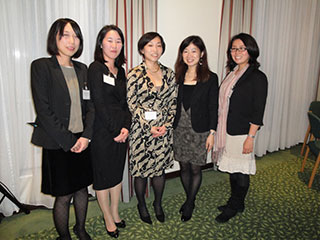 |
|
【9th JGFoS: Social Sciences Sisters (Potsdam, 2012)】 |
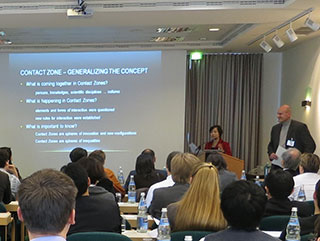 |
|
【9th JGFoS: Dr. Stefan Boeschen, my PGM colleague, and the author (Potsdam, 2012)】 |
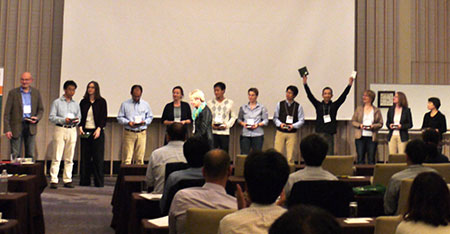 |
|
【10th JGFoS: Planning group members】 |
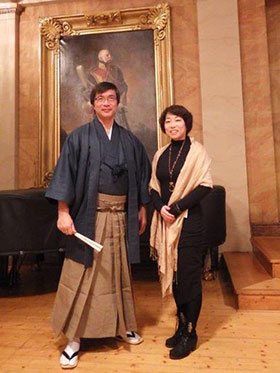 |
|
【Dr. Atsushi Iriki, who delivered a keynote speech at Japan and Germany Science Colloquium, and the author (Göttingen, 2015)】 |